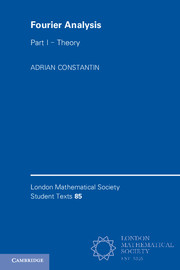Book contents
- Frontmatter
- Dedication
- Contents
- Preface
- 1 Introduction
- 2 The Lebesgue measure and integral
- 3 Elements of functional analysis
- 4 Convergence results for Fourier series
- 5 Fourier transforms
- 6 Multi-dimensional Fourier analysis
- 7 A glance at some advanced topics
- Afterword
- Appendix Historical notes
- References
- Index
2 - The Lebesgue measure and integral
Published online by Cambridge University Press: 05 May 2016
- Frontmatter
- Dedication
- Contents
- Preface
- 1 Introduction
- 2 The Lebesgue measure and integral
- 3 Elements of functional analysis
- 4 Convergence results for Fourier series
- 5 Fourier transforms
- 6 Multi-dimensional Fourier analysis
- 7 A glance at some advanced topics
- Afterword
- Appendix Historical notes
- References
- Index
Summary
The measurement of lengths and areas has a long history dating back to the ancient cultures of Egypt and Greece. It has led to the development of measure theory as an area of modern mathematics, dealing with systematic approaches for measuring complicated objects based on available measurements for simpler objects. The aim of the present chapter is to provide the basic tools for acquiring working knowledge of the Lebesgue integral and its generalisations to abstract measure and integration theory. Rather than providing in this survey full proofs of the main theorems, we motivate/explain the main building blocks of the theory and we illustrate the flexibility of this powerful concept. For the results that are used but not proved we provide adequate references.
Historical considerations
A full appreciation of measure theory requires, we believe, some insight into the genesis of the subject. For this we relied on the material provided in Kupka (1986).
Ancient measure theory
In ancient Egypt, several hundreds of years B.C., the relatively flat ground was basically subdivided into rectangular plots whose area could be expressed in whole numbers of square cubits (the unit of length used in the time of the pharaohs). With regard to measure theory, the vastly greater refinement of Greek mathematics over that of the Egyptians is to a large extent attributed to the necessity of the ancient Greeks to ascertain, for agricultural needs, areas in an irregularly shaped hilly/mountaineous terrain. To obtain approximations of areas of more complicated regions, precise enough to satisfy the practical requirements of the time, the Greek mathematicians used the “paving stone technique”: the given region was paved as exactly as possible with variously chosen rectangular stones of known area, so that the unknown area is well approximated by the sum of the known areas of the individual nonoverlapping stones. The greater sophistication of Greek mathematicians came about because of their subsequent preference of triangles over rectangles. This is advantageous because any region bounded by straight lines can always be paved exactly by finitely many triangles and such regions provide accurate information about certain areas bounded by curves.
- Type
- Chapter
- Information
- Fourier Analysis , pp. 15 - 70Publisher: Cambridge University PressPrint publication year: 2016



